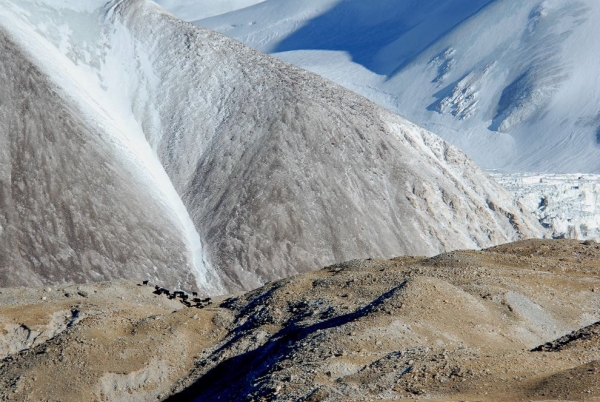Yaks may be climbing higher due to climate change

... by Jason Bittel for National Geographic
A lack of snow on the Tibetan Plateau may be pushing thirsty yak females into steeper habitat.
High on the Tibetan Plateau of Central Asia, you'll find the largest remaining population of wild yaks (Bos mutus). This long-horned, shaggy creature has persevered through more than a century of poaching, habitat loss, and competition with domestic yaks and their human herders.
So in the winters of 2006 and 2012, scientists traveled to this region, sometimes called "the roof of the world," to see how male and female yaks are coping with the impacts of climate change at elevations over 15,000 feet (4,800 meters).
"Many people who are interested in climate change focus on how species will be redistributed in space and in time, where they'll go, but very few have studied potential mechanisms for change," said Joel Berger, lead author of the study and a senior scientist for the Wildlife Conservation Society.
"We focused on the two sexes and asked the question, Which of the two is more likely to be impacted?"
The short answer: Females, which are 20 times more likely to be found near snow patches than are males, according to the scientists' surveys of yak populations and their proximity to glaciers.
That's likely because females lactate through the winter, and have to drink more water from snow patches in order to produce their milk, said Berger, who is also a National Geographic grantee and professor at the University of Montana.
That means mothers may need to go to greater lengths to adapt—including climbing steeper and riskier mountains to find snow.
Life in the Steep Lane
The team also discovered that females are already much more likely to be found on steep slopes.
For the research, published March 2 in the journal Scientific Reports, the scientists used data from 59 international expeditions into the plateau spanning from 1850 to 1925. This time period is important because it provides evidence of how yaks behaved before poaching ramped up in the 1930s.
The International Union for Conservation of Nature officially estimates the global wild yak population at just around 10,000 animals, which has earned it a listing of vulnerable to extinction.
In the past, herds of both male and female yaks—which typically come together only to mate—could be found scattered across the region's valleys, flat areas, and mountain slopes. But this is not true of modern yaks, whose females live in higher elevations.
Berger suspects this is a legacy effect, or a leftover behavior from the days when poaching was so bad that it was dangerous for the yaks to graze in more easily accessible flatlands.
"There's some evidence for this in other species," said Berger. "Elephants are the particularly notable one, where decades after being poached they still show historic memory of being hunted."
It's still unclear why only the females seem to live the high life. However, it's possible that at one time males were also more likely to be found on steep slopes, but that they've somehow returned to their historic behavior more quickly.
High and Dry?
The results aren't surprising to scientists, who have known for a while that animals living in higher elevations will be hit harder by climate change, said Rinjan Shrestha, a conservation scientist with WWF-Canada.
However, it's only been in recent years that research has started to focus on what those impacts may look like, said Shrestha, who has studied how climate change will affect snow leopard habitat.
He also commended Berger and his team for highlighting the ways that human influences, both past and present, affect animals and how this might help scientists figure out how to save them.
This research could also lead scientists to new insights for other endangered species, Berger noted.
After all, if male and female yaks respond differently to environmental stressors, then other animals might, too.

Facebook comments